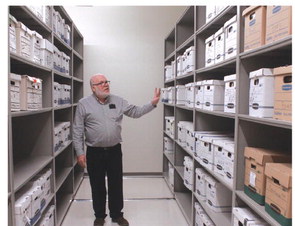preserving the past and launching into thejuture
It is difficult to pinpoint exactly when the first library was established, but one can be certain they looked much different than those of today. The earliest libraries housed collections of writings on clay tablets and papyrus, and even though the ancient forms of writing were eventually replaced with printed books, libraries were essentially the same from the B.C. era to the 20th century.
This all changed with the invention of the internet in the last part of the 20th century. As internet technology improved, libraries adapted from being buildings where books and information are stored to being places where people can experience and learn from the newest technology.
“When I first started here, we had five or six half size tables that had print indexes. They’re all gone now,” lason Dupree said. Dupree is the director of the SWOSU library, and he began working there in 2002, and he has seen the A1 Harris Library undergo major change in the last 20 years.
A public phone, fax machine, and shelves of CDs and microfilm once filled the library. Now, all of that technology is obsolete.
“It’s weird to see the change,” Dupree said. “It’s a sign of the times.” Now students can get much of the information they need without ever touching a physical book by accessing the online academic content made available by the university.
“The budget amount itself has gradually shrunk because of state funding, but what we spend it on has changed. When I first got here, we had a lot more hands on things to do that took money to support,” Dupree said.
He gave the example of binding print magazines and journals. When he began working at the library, it was essentially a full time job for someone to keep up with the binding. Now, that same job only requires a few hours each year.
“Almost half of our budget goes to online subscriptions,” Dupree said.
These online subscriptions give students and faculty access to databases full of peer-reviewed sources and academic journals, the same journals that once required physical space in the library.
This opening of space has led to new resources being provided by the library.
“As we remove shelves and cabinets, we have more study space, which is what a lot of students are after, not so much pulling a book off of a shelf,” Dupree said.
One of the new additions to the library is the media studio in the library basement. The room is filled with lighting equipment, a green screen, high quality microphones, a 4k digital camera, and a new 360 degree camera. Professors have made assignments that require students to use the equipment, and students have made use of the studio for their personal projects.
“I listen and I observe from my conversations with students and faculty to learn what they want, what they need, and what they don’t have access to. If there’s a need on campus, I like to have the library fill that gap,” Dupree said.
While some believe all the new technological inventions will make libraries relics of the past, Dupree doesn’t see that for the future. He said librarians have become tech-savvy and forward thinking to adapt to all the changes, and they will continue to do so in the future.
“We’re maintaining all the new technology and the old technology,” Dupree said.
There is evidence of that dual-minded focus upstairs where the university houses a world-class collection that requires making use of the new technology to preserve the old.
This is the General Thomas P. Stafford Archives, a collection of print items concerning the life and career of General Thomas Stafford. This collection already contains thousands upon thousands of individual items, and it only continues to grow.
“Success breeds more success,” Phillip Fitzsimmons said. Fitzsimmons is the university archivist and special collection librarian, and he has spearheaded the university’s work to preserve and showcase the Stafford pieces.
“Think of an archive as a museum of documents,” Fitzsimmons said. “That’s what we get. It’s a wide array of different kinds of documents.”
The collection is stored in a special vault in the newly renovated second floor of the library. The vault remains at a constant 68 degrees, and it is fire and climate controlled to ensure the safety of the documents stored inside. While there is ample storage space currently available in the vault, Fitsimmons believes that in time it will be full, which he calls “a very good problem.”
The collection does not only remain in the vault, though. Community members and students alike are welcome to visit the archive during open hours and sit in the special reading room where they can read the actual documents from the special collections. Those interested in reading the historical documents for themselves can check the SWOSU library website for current archive hours.
Not only does Fitzsimmons acquire and handle the physical documents that are part of the collection, but he also scans and digitizes the pieces to make them available online through the SWOSU Digital Commons.
Along with publishing scholarly and creative pieces from the students and faculty of SWOSU, the Digital Commons also “provides a wide array of materials celebrating the history of the University and the diverse peoples and cultures of western Oklahoma,” according to its website.
The Digital Commons allows people from around the world access to collections available through the SWOSU library. Some of the documents are official university reports that need to be made available to the public, but many of the documents are items of historical and academic significance.
One of the collections available on the Digital Commons that contains publications of international and literary significance is the Mythopoeic Society collection. Fitzsimmons is a member of the Mythopoeic Society, a group that discusses fantasy literature and the works of authors such as Tolkien and C.S. Lewis.
Before archiving the Stafford collection, Fitzsimmons archived the documents of the Mythopoeic Society, and it was a way to practicing the digitization process before receiving the all-important Stafford collection.
“It was a dream idea that had always been there,” he said. “I wanted to have a major collection completed before we received the Stafford collection because I wanted to make sure I got it right. It was like practice, and I always had the passion.”
Although Fitzsimmons has a personal interest in the Mythopoeic Soceity, he said it is not the center of his attention. “My priorities are Stafford, SWOSU history, and then everything else.”
Yes, the modern library is quite different than those of the past. Libraries are now about so much more than books, but they still provide knowledge and resources that would not otherwise be available to communities. With the efforts being made by SWOSU to adjust to the modern times and to preserve the history of the past, Weatherford is sure to have a world-class center or learning and research for the years to come.


